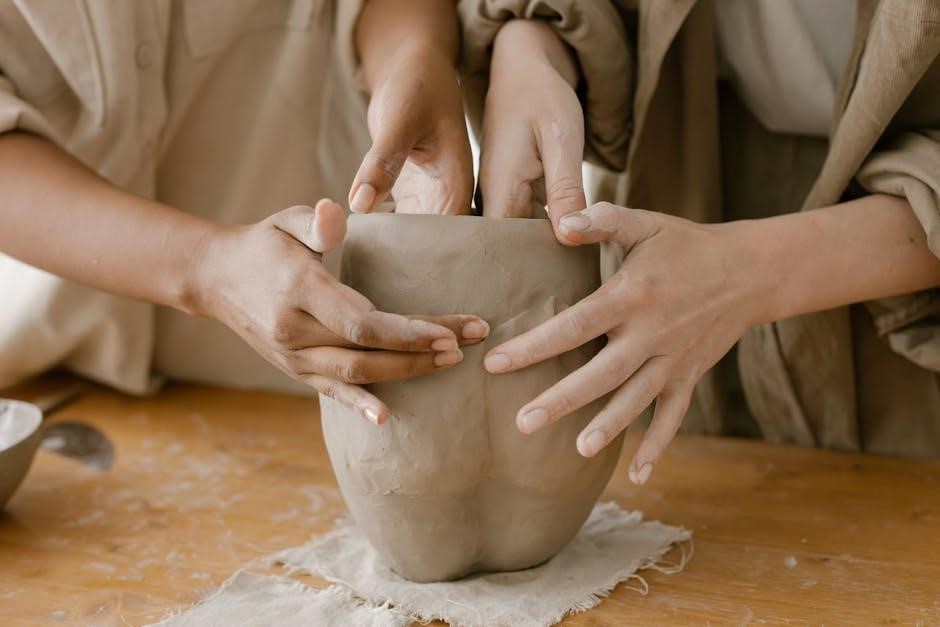The 12-week 400m training program is a comprehensive plan designed to enhance speed, endurance, and power, structured to improve performance and prevent injuries in sprinters through targeted workouts.
Overview of the Program Structure
The 12-week 400m training program is meticulously designed to optimize performance through a structured progression of speed, endurance, and strength development. Divided into three phases, the program ensures a balanced approach to building foundational fitness, enhancing power, and refining race-specific skills. Phase 1 (Weeks 1-4) focuses on establishing a base level of speed endurance and plyometric ability. Phase 2 (Weeks 5-8) emphasizes strength and power development through targeted lifting circuits and acceleration drills. Finally, Phase 3 (Weeks 9-12) transitions into race-specific preparation, simulating race conditions, refining strategies, and tapering to peak performance. Each week builds on the previous one, ensuring progressive overload and adaptation. The program integrates a mix of track workouts, hill sprints, interval training, and recovery sessions to cater to the unique demands of the 400m dash. This structured approach minimizes injury risk while maximizing athletic potential.
Importance of Periodization in Training
Periodization is crucial in the 12-week 400m training program as it ensures a structured and systematic approach to athlete development. This method prevents overtraining and injury by allowing for strategic planning and recovery phases. By organizing training into specific cycles, athletes can progressively build speed, strength, and endurance without plateauing. Periodization also ensures that peak performance coincides with race day, optimizing results. The program’s three distinct phases—foundation building, strength and power development, and race-specific preparation—demonstrate effective periodization. Each phase focuses on particular skills, gradually intensifying to meet the demands of the 400m dash. This approach not only enhances physical adaptation but also maintains mental freshness, preventing burnout. A well-planned, periodized program is essential for achieving maximum potential and success in the 400m event.
Setting Realistic Goals for the 400m Dash
Setting realistic goals is essential for success in the 12-week 400m training program. Athletes should establish specific, measurable, and achievable targets based on their current fitness level and performance history. Aiming to improve personal best times or mastering race strategies can serve as clear objectives. Breaking down the season into short-term and long-term goals helps maintain focus and motivation. For instance, short-term goals might include increasing speed endurance or perfecting running technique, while long-term goals could focus on achieving a new personal record or qualifying for a major event. Regularly assessing progress ensures goals remain relevant and challenging. Having a clear vision of what can be achieved within the 12-week timeframe keeps athletes committed and driven, fostering a positive and productive training environment.

Phase 1: Foundation Building (Weeks 1-4)
Phase 1 focuses on building foundational endurance, speed, and strength through plyometrics, hill sprints, and interval training, progressively increasing intensity and volume to prepare for advanced phases.
Week 1: Speed Endurance and Plyometrics
Week 1 introduces speed endurance and plyometric exercises to build foundational fitness. Athletes perform repetitions of 250m-300m at high intensity, focusing on maintaining form and pace. Plyometric drills, such as two-legged hopping and bounding, enhance explosiveness and power. A typical session includes a warm-up routine with 4x100m build-ups, followed by the main workout and a cool-down with stretching. Lifting circuits, including exercises like high pulls and dumbbell snatches, are incorporated to improve strength. Core strengthening exercises like lunges and dips are also emphasized to enhance stability. Recovery sessions involve light jogging and walk-back recovery to ensure adaptation. This phase lays the groundwork for more intense training in subsequent weeks, balancing speed, strength, and endurance development.

Week 2: Increasing Volume with Longer Repetitions
Week 2 focuses on increasing training volume and intensity through longer repetitions and endurance challenges. Athletes perform repetitions of 300m-400m at a slightly faster pace, aiming to build lactate threshold and stamina. Fartlek runs are introduced to simulate race conditions, alternating between high-intensity bursts and active recovery. Strength training includes lifting circuits with exercises like front squats, bench presses, and bent-over rows, targeting muscular endurance. Core workouts, such as split squats and dips, are emphasized to enhance stability and power. Recovery sessions involve walk-backs and light jogging to aid adaptation. This phase balances intensity with recovery, ensuring athletes gradually build endurance without overtraining. The goal is to improve speed endurance while laying a solid foundation for more specialized training in upcoming weeks.
Week 3 introduces hill sprints and interval training to enhance explosive power and speed endurance. Athletes perform short, intense sprints uphill (30-50 meters) to build acceleration and strength, followed by walk-back recovery. Interval sessions include 4-6 repetitions of 200m runs at a fast pace, with 2-3 minutes of active recovery. These workouts target lactate threshold improvement and race-specific conditioning. Strength training focuses on exercises like standing triple jumps, lunges, and bench presses to develop muscular power. Core stability drills, such as split squats and dips, are also emphasized to improve running efficiency. Recovery remains critical, with light jogging and stretching incorporated to prevent overtraining. This phase bridges the gap between foundational endurance and race-specific speed, preparing athletes for the demands of the 400m event.
Week 4: Fartlek Runs for Enhanced Endurance
Week 4 focuses on fartlek runs to boost cardiovascular endurance and mental toughness. Fartlek, meaning “speed play” in Swedish, involves varying intensities over a continuous run. Athletes perform 6-8 repetitions of 300-400m at a fast pace, with 1-2 minutes of active recovery. This format mimics race conditions, improving lactate threshold and stamina. Strength training includes exercises like push-ups and core circuits to maintain power. Recovery sessions feature light jogging and stretching to prevent overtraining. This phase transitions athletes from foundation building to more race-specific endurance, ensuring they can sustain effort over the 400m distance. The combination of fartlek runs and recovery prepares athletes for the intensity of the upcoming weeks, focusing on endurance and speed endurance simultaneously.

Phase 2: Strength and Power Development (Weeks 5-8)

This phase focuses on building muscular power and explosive acceleration through weightlifting, plyometrics, and resistance drills, enhancing speed and resilience for a faster, more resilient performance.
Week 5: Lifting Circuits and Core Strength
Week 5 emphasizes building muscular endurance and core stability through structured lifting circuits. Athletes engage in exercises like high pulls, DB snatch, hang cleans, and front squats, performed in a circuit format with 2-3 sets of 8-12 repetitions. Core workouts include bench press, back squats, bent-over rows, and leg extensions, focusing on maintaining proper form and engaging the core for stability. These sessions aim to enhance power output and resilience, reducing injury risk. The circuit format allows for minimal rest between sets, promoting muscular endurance. Additionally, plyometric drills like two-legged hopping and bounding are incorporated to improve explosive force. This week transitions from foundational strength to more dynamic, sport-specific movements, ensuring athletes build the necessary power and stability for the 400m dash. Proper form and progressive overload are emphasized to maximize gains.
Week 6: Acceleration Drills and Resistance Training
Week 6 focuses on refining acceleration techniques and incorporating resistance training to enhance explosive power. Athletes perform 20m and 30m acceleration drills, emphasizing proper posture, leg drive, and arm swing. Resistance bands are used to overload the sprinting motion, improving force production. Strength sessions include back squats, deadlifts, and step-ups, targeting the lower body and core. Plyometric exercises like box jumps and depth jumps are added to develop elastic power. The week also includes uphill sprints for resistance-based endurance. These workouts aim to improve neuromuscular coordination and muscle recruitment patterns. By the end of Week 6, athletes should notice enhanced acceleration and sustained power during sprints. Proper form and progressive overload are prioritized to ensure safe and effective gains. This phase bridges foundational strength with sport-specific speed development.
Week 7: Focus on Maximum Velocity Development
Week 7 emphasizes developing maximum velocity through short, high-intensity sprint intervals. Athletes perform 60m and 80m sprints at maximum effort, focusing on maintaining proper mechanics and explosive power. Resistance training includes hang cleans and high pulls to enhance power output. Plyometric exercises like bounding drills and box jumps are incorporated to improve elastic energy utilization. The week also introduces uphill sprints to combine speed with strength. Proper recovery and form are prioritized to avoid injury. This phase transitions athletes from building foundational strength to applying it in sprint-specific contexts. The goal is to optimize speed and power, ensuring athletes can sustain high velocities over longer distances. By refining technique and increasing intensity, Week 7 sets the stage for race-specific preparation in later phases.

Week 8: Integration of Strength and Speed
Week 8 focuses on integrating strength gains with speed development, blending power and endurance. Athletes perform lifting circuits, including back squats and bench presses, to maintain strength. Speed workouts feature shorter sprints (50-100m) at high intensity, emphasizing proper mechanics and acceleration. Hill sprints are introduced to combine strength and speed, while interval runs (200-400m) at race pace build endurance. Plyometric exercises like box jumps and depth jumps enhance explosiveness. Recovery sessions include light runs and active recovery to ensure athletes are fresh for race-specific work. This phase bridges the gap between strength development and race readiness, ensuring athletes can apply their power effectively on the track. The goal is to create a seamless transition to race-specific training while maintaining peak physical condition.

Phase 3: Race-Specific Preparation (Weeks 9-12)
Phase 3 focuses on race-specific preparation, simulating race conditions, refining strategy, and tapering. Athletes practice race scenarios, adjust techniques, and recover strategically to peak performance for race day success.
Week 9: Simulating Race Conditions
Week 9 emphasizes race-specific preparation by simulating actual competition conditions. Athletes engage in race-pace runs to build mental and physical resilience. Workouts include 2-3 repetitions of 400m at race pace, followed by active recovery. This phase also incorporates pro/relaxed runs, where athletes alternate between race pace and relaxed efforts to mimic race dynamics. The volume of training is slightly reduced to allow for recovery while maintaining intensity. Drills focus on race strategy, such as breaking the race into segments and perfecting the finish. Strength sessions are tailored to maintain power without overloading the body. Recovery techniques, including dynamic stretches and strides, are prioritized to ensure peak performance. This week is critical for mental preparation, as athletes learn to handle race pressure and fine-tune their strategy for optimal results.
Week 10: Refining Race Strategy and Technique
Week 10 focuses on refining race strategy and technique to optimize performance. Athletes practice race-specific scenarios, including pacing, acceleration zones, and finish-line bursts. Drills emphasize proper running posture, arm swing, and leg drive to maximize efficiency. Video analysis is used to identify and correct technical flaws. Mental preparation is intensified, with visualization exercises to build confidence and race-day composure. Speed endurance workouts, such as 3x200m at race pace with short recoveries, are designed to fine-tune race execution. Strength sessions focus on maintaining power while reducing volume to avoid fatigue. The week also includes race simulations with competitive scenarios to adapt to varying race dynamics. This phase ensures athletes are technically sound, tactically aware, and mentally prepared for peak performance on race day.
Week 11: Taper and Rest to Optimize Performance

Week 11 focuses on tapering and rest to allow the body to recover and optimize performance. Training volume is significantly reduced to prevent overtraining and injury, while intensity remains high to maintain fitness. Athletes engage in shorter, more focused speed sessions, such as 4x150m at race pace with ample recovery. Strength training is scaled back, emphasizing active recovery techniques like light runs, stretching, and foam rolling. Nutrition and sleep are prioritized to aid muscle repair and energy replenishment. Mental preparation intensifies with visualization exercises to build race-day confidence. The goal is to ensure athletes feel fresh, sharp, and ready to deliver their best performance in the final week. This strategic taper ensures peak physical and mental readiness for race day.
Week 12: Final Preparations and Race Day Strategy
Week 12 is dedicated to finalizing preparations and refining race day strategy. Training volume is minimal, with a focus on maintaining sharpness through short, high-intensity bursts, such as 3-5x60m sprints at maximum velocity. Rest and recovery are prioritized to ensure peak physical readiness. Athletes review and practice their race day warm-up routine, including dynamic stretches and strides. Mental preparation is intensified, with visualization exercises to build confidence and focus. Nutrition strategies, such as carb-loading and hydration, are fine-tuned to optimize energy levels. On race day, athletes execute their pre-planned strategy, focusing on a strong start, maintaining composure in the middle 200m, and unleashing a powerful finish. The emphasis is on trusting the training, staying disciplined, and delivering the best possible performance. This week is about mental toughness, strategic execution, and leaving everything on the track.

Additional Considerations
Proper nutrition, recovery, and mental preparation are vital. Consistent training adjustments, injury prevention, and tracking progress ensure long-term success and peak performance in the 400m dash.
Nutrition and Recovery Strategies
A well-balanced diet is crucial for optimal performance in the 400m dash. Athletes should focus on consuming high-quality carbohydrates for energy, lean proteins for muscle repair, and healthy fats for overall health. Proper hydration is also essential to maintain performance and prevent fatigue. Post-workout recovery nutrition, including a mix of carbohydrates and protein within 30 minutes of training, helps replenish energy stores and support muscle recovery. Additionally, incorporating recovery techniques such as foam rolling, stretching, and adequate sleep can significantly enhance training adaptation. A structured nutrition plan tailored to individual needs ensures athletes are fueling their bodies for peak performance throughout the 12-week program.
Mental Preparation and Focus Techniques
Mental preparation is a cornerstone of success in the 400m dash, requiring consistent focus and resilience. Athletes should practice visualization techniques to mentally rehearse race scenarios, building confidence and composure under pressure. Positive self-talk and affirmations can enhance motivation and perseverance during challenging workouts. Setting clear, achievable goals helps maintain focus and drive throughout the 12-week program. Additionally, mindfulness and breathing exercises can improve concentration, allowing athletes to stay present and composed during training and competition. Regular mental drills, such as reviewing past performances and identifying areas for improvement, further strengthen mental toughness. By cultivating a strong mental game, athletes can optimize their physical performance and approach race day with clarity and determination.
Tracking Progress and Adjustments
Tracking progress is essential to ensure the effectiveness of the 12-week 400m training program. Athletes should maintain a detailed training log to record workout specifics, such as distances, times, and perceived exertion. Regularly assessing key metrics like sprint times, endurance levels, and strength gains provides insights into improvement. Coaches and athletes can use this data to identify plateaus or areas for adjustment, ensuring the program remains challenging yet achievable. Adjustments might include modifying workout intensity, volume, or technique to align with current fitness levels. Incorporating feedback sessions with coaches helps refine training strategies, while celebrating milestones boosts motivation. Continuous monitoring allows for tailored modifications, ensuring the program evolves with the athlete’s progress, ultimately leading to peak performance by race day.
Avoiding Injuries and Maintaining Consistency
Avoiding injuries is critical to maintaining consistency in the 12-week 400m training program. Proper warm-ups, cooldowns, and recovery sessions are essential to prevent muscle strains and overtraining. Incorporating structured rest days and cross-training can help manage workload. Paying attention to technique during drills and strength exercises reduces the risk of injuries. Gradually increasing intensity and volume ensures the body adapts without overload. Listening to your body and adjusting training based on feedback is key to long-term consistency. A well-balanced approach, including proper nutrition and sleep, supports overall health and resilience. Consistency is maintained by adhering to the program’s schedule while being flexible enough to make necessary adjustments. This balanced approach ensures athletes reach race day in optimal condition, ready to perform at their best.
The 12-week 400m training program successfully balances speed, endurance, and technique, guiding athletes to peak performance. Completion marks a significant achievement, preparing them for future challenges and continued growth.
Summarizing the 12-Week Journey

The 12-week 400m training program is a well-structured journey designed to enhance speed, endurance, and power. It progresses through three distinct phases: Foundation Building, Strength and Power Development, and Race-Specific Preparation. Each phase builds on the previous one, ensuring athletes gradually improve their performance. The program emphasizes periodization, balancing intense training with recovery to optimize results. By incorporating speed endurance, hill sprints, plyometrics, and strength circuits, athletes develop the necessary skills and resilience for the 400m dash. The final phase focuses on race strategy and mental preparation, ensuring athletes are ready to perform at their best. This program not only improves physical abilities but also fosters mental toughness and discipline, essential for achieving peak performance. Completing the 12-week journey prepares athletes for the demands of competition and sets a strong foundation for future training and growth.
Looking Ahead Beyond the Training Program
Completing the 12-week 400m training program marks a significant milestone, but it’s just the beginning of an athlete’s journey. Post-program, athletes should focus on setting new, challenging goals to continue progression. Maintaining consistency in training is crucial, as regression can occur without regular practice. Athletes can explore advanced techniques, refine their race strategies, or incorporate cross-training to enhance overall fitness. Rest and recovery remain vital to avoid burnout and prevent injuries. Long-term development involves periodized training plans, ensuring a balanced approach to speed, strength, and endurance. Athletes can also delve deeper into nutrition, mental preparation, and recovery strategies to further optimize performance. The skills and discipline gained from the program provide a strong foundation for future success, whether competing at higher levels or pursuing new challenges in track and field.






























